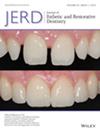使用 37% 过氧化卡巴酰胺与 35% 过氧化氢的诊所牙科漂白:随机双盲临床试验
IF 3.2
3区 医学
Q1 DENTISTRY, ORAL SURGERY & MEDICINE
引用次数: 0
摘要
比较使用 35% 过氧化氢(HP)或 37% 过氧化卡巴酰胺(CP)进行诊室牙齿漂白的牙齿敏感性(TS)和漂白效果(BE):35% HP 或 37% CP。使用 VAS 和 NRS 量表记录漂白后即刻、1 小时、24 小时和 48 小时内的 TS。在漂白前和漂白后 1 个月,使用色导单位(ΔSGUs)和分光光度计(ΔEab、ΔE00 和 ΔWID)对 BE 进行评估。TS 采用 McNemar 检验和配对 t 检验(VAS)或 Wilcoxon 符号秩(NRS)进行评估。采用配对 t 检验分析 BE(α = 0.05)。结果 37% CP 的 TS 风险和强度较低(p = 0.003 和 p <0.005)。尽管 1 个月后两组之间存在明显差异(ΔSGU 和 ΔE00;p < 0.05),但两组的颜色测量值都超过了 50%:50%的可感知性/可接受性阈值:试验注册:ClinicalTrials.gov identifier:RBR-683qhf本文章由计算机程序翻译,如有差异,请以英文原文为准。
In‐Office Dental Bleaching Using 37% Carbamide Peroxide Versus 35% Hydrogen Peroxide: A Randomized, Double‐Blind Clinical Trial
ObjectiveCompare the tooth sensitivity (TS) and bleaching efficacy (BE) of in‐office dental bleaching performed with 35% hydrogen peroxide (HP) or 37% carbamide peroxide (CP).Materials and MethodsSixty‐six participants were randomly divided into two groups according to the bleaching gel applied to the right hemiarch: 35% HP, or 37% CP. TS was recorded immediately after, up to 1, 24, and 48 h after bleaching, using the VAS and NRS scales. BE was assessed before bleaching and 1 month after using color guide units (ΔSGUs) and a spectrophotometer (ΔE ab E 00 , and ΔWID t ‐test (VAS) or Wilcoxon signed rank (NRS). The paired t ‐test was used to analyze BE (α = 0.05).ResultsTS risk and intensity were lower for the 37% CP (p = 0.003 and p < 0.005). Despite significant differences between the groups after 1 month (ΔSGU and ΔE 00 ; p < 0.05), the color measurements of both groups exceeded the 50%:50% perceptibility/acceptability threshold.ConclusionIn‐office dental bleaching using 37% CP resulted in reduced risk and TS intensity, without prejudice to the BE.Clinical RelevanceThe use of 37% CP for in‐office dental bleaching could decrease TS risk and intensity without affecting BE.Trial Registration: ClinicalTrials.gov identifier: RBR‐683qhf
求助全文
通过发布文献求助,成功后即可免费获取论文全文。
去求助
来源期刊
CiteScore
6.30
自引率
6.20%
发文量
124
审稿时长
>12 weeks
期刊介绍:
The Journal of Esthetic and Restorative Dentistry (JERD) is the longest standing peer-reviewed journal devoted solely to advancing the knowledge and practice of esthetic dentistry. Its goal is to provide the very latest evidence-based information in the realm of contemporary interdisciplinary esthetic dentistry through high quality clinical papers, sound research reports and educational features.
The range of topics covered in the journal includes:
- Interdisciplinary esthetic concepts
- Implants
- Conservative adhesive restorations
- Tooth Whitening
- Prosthodontic materials and techniques
- Dental materials
- Orthodontic, periodontal and endodontic esthetics
- Esthetics related research
- Innovations in esthetics

 求助内容:
求助内容: 应助结果提醒方式:
应助结果提醒方式:


